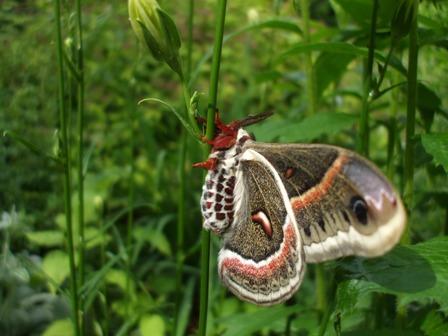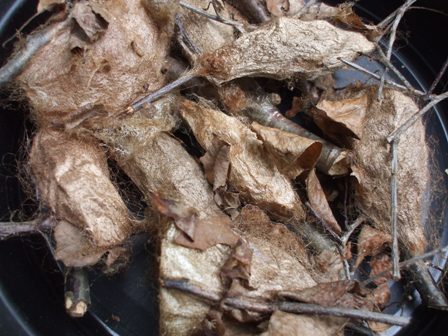 If you’re under the impression that moths are dull creatures who eat holes in sweaters, you haven’t encountered a giant silk moth. Luna moths, Promethea moths, Polyphemous moths, and Cecropia moths are all native silk moths of the subfamily Saturniinae.
If you’re under the impression that moths are dull creatures who eat holes in sweaters, you haven’t encountered a giant silk moth. Luna moths, Promethea moths, Polyphemous moths, and Cecropia moths are all native silk moths of the subfamily Saturniinae.
These amazingly large, stunningly beautiful moths are found throughout Massachusetts, but we rarely see them. Flying mostly at night and spending much of their lives as caterpillars and cocoons, these moths fly under the radar. Observing one in action is always a WOW experience.
Life Cycle of The Cecropia Moth
In late May and early June, adult Cecropia moths (pictured above) emerge from their cocoons. With a wingspan of 5 to 6 inches, the Cecropia moth is the largest moth in North America. Adults are born without mouth parts, do not feed, and have one job: to mate and reproduce. Males have large feathery antenna, which can pick up the scent of a female from a mile away.
After mating, females lay more than a hundred eggs, usually in small rows on the underside of leaves. Around 10 to 14 days later, tiny black caterpillars emerge. The caterpillars are eating machines and feed on the leaves of many common trees including cherry (a favorite), sassafras, lilac, ash, apple, poplar, and willow.
The caterpillars go through 5 instars (i.e., skin sheddings), and grow very large. By the 5th instar they’re often at least 4 inches long and thicker than an adult thumb. They are also remarkable looking, with a frosted green coloring and red, blue, and yellow knobs extending from their bodies. Children often remark that it looks like ladybugs are riding on the caterpillar’s heads!
The caterpillars have many enemies and mortality rates are high. After weeks of eating and growing, the rare caterpillar that has successfully reached the 5th instar is ready to cocoon. On a branch or twig, the caterpillar will spin a rough, brown, spindle-shaped cocoon. The caterpillar will spend the winter in the cocoon, transforming into an adult moth, ready to emerge in late spring.
Status of Cecropias
Sadly, Cecropia moth numbers appear to be in decline due to habitat loss, pesticide use, and parasitism by a tachinid fly introduced to control the Gypsy Moth. (See Boettner et al, 2000). Maintaining a pesticide-free yard full of native plants and natural spaces is one way to help these amazing creatures. Some people go a step further and raise silk moths to increase their numbers, a labor-intensive and rewarding experience.
Learn More
Join a mothing or insect program at a Mass Audubon wildlife sanctuary near you.





I am watching four very large caterpillars and a couple clusters of eggs that hatched into many tiny striped caterpillars. All are eating styrax japonicus, Japanese Snowbell leaves, here in Southern Maine
I’ve seen no Promethia moths.
Update: The four large caterpillars have spun into cocoons, wrapped inside leaves.
Little ones are still eating and growing.
Will all these overwinter in the chrysalis stage and hatch next spring? Or will the large ones hatch this summer/fall?
Finally saw one of these beauties the other day. Amazing color and the sheer size of them was truly a sight to behold. It’s a shame they don’t live longer but what can you do?
I have a cacophony on my lilac bush. I’ve been told it’s a silk moth. I’ve been watching to see if it’s hatched. Do you think I will see this happen or most likely miss it. I want to leave it in its natural spot , but I’d love to see it too!
Found a polyphemus worm outside my shop in Arkansas. It was brutal cold and he wasn’t moving so i brought him inside and left him in a wax paper Togo coffee cup. By the end of the day he had begun to stir and proceeded to use the leaves I dropped in for gnosh as a blanket to insulate his silk cocoon. It had been months, must have been late September early October whenever I found him! This morning the cat started to attack the lone paper cup setting aside on a bookshelf. I didn’t think much of it at first until I heard fluttering from inside the cup. It was amazing. His wings were tiny! The way illustrations of a chinese dragon’s are set high atop a long wriggly body almost ornamental. I had to rush off to work and didn’t think to get pictures right away. I’m kicking myself. whenever I returned from work his wings had reached full size, in a matter of hours, and he wanted out… I’m letting him hang out back of the house in the work space until these winds die down.
We live in Michigan and just found a stage 5 caterpillar on a birch tree. I’ve put it in a large pitcher with some birch branches. Covered the top with netting. If this caterpillar does make a cocoon what do I need to do to and with the container?
The chrysalis doesn’t need any care. Just keep your eye on the container so you can release the moth once it has eclosed.
I have three in cocoons and three that have hached. Two are colorful but one is grey. Can someone tell me why it’s grey?
Hi Lucas,
Assuming you were referring to the color of the cocoons, it’s difficult to say without seeing them up close, but I checked in with our Wildlife Information Line Specialist and her best guess was maybe some sort of parasitic wasp. They will often lay their eggs inside the chrysalis of another insect and then the hatched larvae will devour the host. Here is a blog post that describes this process in detail: http://www.abundantnature.com/2012/06/inside-cecropia-moth-cocoon.html
Hi Lucas,
It’s difficult to say for sure without seeing it, but I spoke to our Wildlife Information Line specialist and she had this to say:
“My best guess would be some sort of parasitic wasp. They will often lay their eggs in the chrysalis of another insect, and the larva will kill the host. Check this out
http://www.abundantnature.com/2012/06/inside-cecropia-moth-cocoon.html”
Let us know if this is helpful!
I am looking at one now in Western Mass. So amazing.
i have one on my back deck and i am in Maine. So beautiful!!
I have beautiful giant silk moth hanging on the side of my wooden porch step. It’s next to its open cocoon. I’m in central IL and glad to see we have them.
I have one of these on my window box. I thought it was a butterfly!! It is beautiful. It looks like there is another sac on the window box as well. I live in Buffalo NY. I can not believe this is a moth because it is so pretty!!
Just got some great photos of two moths mating, at Village Green Family Campground in Brimfield, Mass. Go the their facebook page to see the photo… https://www.facebook.com/121452971217186/photos/pcb.1305205469508591/1305204446175360/?type=3&theater
Hello, this Crecopia silk moth has attached itself to my screen door. I live in Sedona, AZ. About 4 days ago we saw it fall to the deck floor as we were folding up the chairs. I thought it was injured so I gave it Reiki Healing energy. I didn’t touch it not knowing what it was and what it was doing. The next morning we found it had attached itself to the screen door. Many times of opening and closing the door for the next two days did not disturb it from staying there. I gave it Reiki again and though oh dear it has not eaten in days, it must be thirsty, So with an eyedropper I dripped some water onto the screen hoping it might help. the next morning I saw eggs, although I was not sure they were eggs or debris maybe from a dying moth. I thought it was a butterfly so only researched on butterflies, never knowing a moth can be so colorful and beautiful. So now I know what it is, but what do I do with it. I don’t have any fruit trees in my garden to transport it too. I dare not touch it as I’m afraid I might touch the wings or body to strongly. but the eggs I can move to somewhere where they will be able to eat and grow, if the birds don’t get them first. I have piñon pine trees in my garden. Please advise!
Hi Barbara,
I checked in with a Mass Audubon scientist, and here is his response:
Although anything’s possible, the cecropia moth’s native range in the United States is east of the Rocky Mountains; they are not known from Arizona. However, the similar Columbia silkmoth, a moth in the same genus (Hyalophora) as the cecropia moth, does live in Arizona. It seems more likely that this moth is a Columbia silkmoth.
If you are careful, handling the moth by scooping it up and supporting its body shouldn’t cause any harm—they’re tough enough for that. However, it is likely that the adult will die shortly after laying eggs; adult silkmoths don’t feed, so their lifespan is pretty short (about 2 weeks). Some people have a skin sensitivity to moth scales or hairs, so it’s prudent to be gentle when handling it to minimize exfoliation.
Regarding what to do with the eggs, yes, a screen door doesn’t seem like a good place for them. Based on information on Columbia silkmoths from the Butterflies and Moths of North America website (http://www.butterfliesandmoths.org/species/Hyalophora-columbia), host plants for this species include cherries, roses, willows, buckbrush, and others. Some silkmoth species do feed on pines, but apparently Columbia silkmoth is not among them. If suitable host plants are in the neighborhood, it might be worthwhile to attempt to relocate the eggs, though this could be unsuccessful.
Just wanted to let you know that in the last week I know of two that have been seen in northern NH and VT!
These moths are so amazing! I had never seen one until I found it in a building where I have chickens. I took pictures and videos. I moved the moth to a safe place, and, the next day when I went back to see if it read okay, it was mating! I have located the two sacs they made and look forward to seeking them come forth! I will do my best to protect them. By the way, I live in the center of North Carolina.
The beauty, the delicacy, the ineffability.